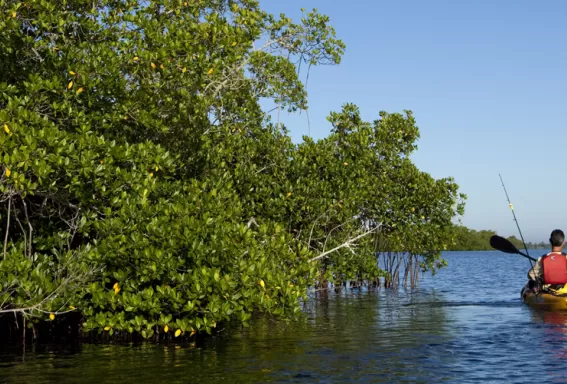The Caloosahatchee River
The Caloosahatchee River and its meandering tributaries represent the newest leg of the Great Calusa Blueway. This is the segment where blue turns green – as in lush, towering leather ferns, stately oaks dripping with moss and verdant vegetation along every shore.
From the Hendry-Lee county line west to the mouth of the river is 38 miles. But when you add in the creeks and feeder rivers, another 52 miles exist for kayakers and canoeists to explore.
The Calusas used this river as a highway. So did early settlers to Fort Myers. Today, powerboats and sailboats traverse the Intracoastal Waterway, which connects Texas to Maine. But the river is wide enough to accommodate everyone – even wildlife. You wouldn’t know you’re paddling in a county of more than a half-million residents.
Unlike the Phase 1/Estero Bay and Phase 2/Pine Island Sound segments of the blueway, this Phase 3 section does not have trail markers. Instead, GPS coordinates for the mouth of each tributary are provided.
Travel east to west and you’ll discover places you want to visit more than just once. Among them:
- Hickey's Creek Mitigation Park: A great day trip or half-day trip from Caloosahatchee Regional is to go downstream to the mouth of Hickey’s Creek and then head up the corkscrew of a creek to the park. Stretch your legs and picnic before paddling back. This creek teems with life, from Doritos-sized freshwater turtles to 4-foot-tall sandhill cranes.
Tip: Watch for the camel in a backyard at the mouth of the creek’s south bank
- Oxbows: A crazy-sounding word? Yes. This is the term for a bend in the river – its original footprint. Pioneering entrepreneurs straightened the Caloosahatchee by dredging it all the way to Lake Okeechobee and, in doing so, they left islands and curvy bends outside the new channel.
Tip: Oxbow islands such as Dr. Sam Nixon Oxbow Island and Columbus G. McLeod Preserve offer bird watching, nature study and photography and a place to stretch.
- Orange River: At its mouth and just upstream near the power plant, you find manatees in the winter. Farther upriver from Lee County Manatee Park, you find a slice of Old Florida.
Tip: A gentle current makes travel easy both directions.
- Caloosahatchee Creeks Preserve: Perfect for the novice paddler, this park lets you launch from North Fort Myers into a maze of creeks. You can loop around and come back within the hour and never even dip your paddle in the much-wider Caloosahatchee.
Tip: A boardwalk offers sightings of marshes and wildlife such as the occasional gator.
- Yellow Fever Creek: That’s what the settlers called this North Fort Myers creek, but developers rebranded it as Hancock Creek. Although it winds through neighborhoods, it also preserves a “wild” feel.
Tip: Go at sunset on a full moon and watch bats flit around feeding on insects as you paddle back to your launch site.
- Four Mile Cove: This Cape Coral jewel is best explored in dry months such as November through April. Its dense vegetation is reminiscent of Gilligan’s Island meets Robinson Crusoe.
Tip: Check out the picnic pavilions on stilts with family and friends.

